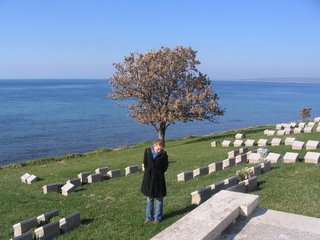The Dardanelles in Greek Myth and ANZAC History
 About 6 hours by bus from Istanbul is the Gelibolu (Gallipoli in English) Peninsula, a stunning piece of land that has the dubious distinction of being one of the borders of the waterway, the Dardanelles. This strait is the middle link between a long string of seas and oceans that connect the Black Sea to the Mediterranean Sea and beyond. To give a sense of this importance, the Dardanelles connect Russia, Bulgaria, Romania, Ukraine, Georgia, Turkey, and many countries lying further inland, with the rest of the world. Throughout history, the strait has been crucial to crossing from Europe to Asia or vice versa. Alexander the Great used it to expand his empire out to what is today Afghanistan. The Persian ruler Xerxes crossed it to get to Greece. And in WWI, Winston Churchill, then the British First Lord of the Admiralty, saw the taking of the Dardanelles as key to Allied success (get the Dardanelles, and you break Turkey’s relationship with Germany).
About 6 hours by bus from Istanbul is the Gelibolu (Gallipoli in English) Peninsula, a stunning piece of land that has the dubious distinction of being one of the borders of the waterway, the Dardanelles. This strait is the middle link between a long string of seas and oceans that connect the Black Sea to the Mediterranean Sea and beyond. To give a sense of this importance, the Dardanelles connect Russia, Bulgaria, Romania, Ukraine, Georgia, Turkey, and many countries lying further inland, with the rest of the world. Throughout history, the strait has been crucial to crossing from Europe to Asia or vice versa. Alexander the Great used it to expand his empire out to what is today Afghanistan. The Persian ruler Xerxes crossed it to get to Greece. And in WWI, Winston Churchill, then the British First Lord of the Admiralty, saw the taking of the Dardanelles as key to Allied success (get the Dardanelles, and you break Turkey’s relationship with Germany).  For over 5,000 years people have recognized the importance of this waterway, exemplified by the longstanding city of Troy. Yes! Troy!! Evidence of Troy’s beginning dates from about 3,000 BCE, long before the Troy of the myth. From that year until about year 1,300 a city has stood on that ground overlooking the plain that sweeps to the Dardanelles.
For over 5,000 years people have recognized the importance of this waterway, exemplified by the longstanding city of Troy. Yes! Troy!! Evidence of Troy’s beginning dates from about 3,000 BCE, long before the Troy of the myth. From that year until about year 1,300 a city has stood on that ground overlooking the plain that sweeps to the Dardanelles. Troy thrived in that location. Before humans developed a technique to sail against the wind, they were at the mercy of prevailing winds. Therefore, ships wishing to sail through the Dardanelles stopped at Troy while they waited for favorable winds. Regardless of whether there actually was a Trojan War as described in Homer’s Iliad, the site has an enormous importance archaeologically and historically. Personally, I believe that there was a Trojan War, Gods, golden apples, Achilles’ heel and all.
Troy thrived in that location. Before humans developed a technique to sail against the wind, they were at the mercy of prevailing winds. Therefore, ships wishing to sail through the Dardanelles stopped at Troy while they waited for favorable winds. Regardless of whether there actually was a Trojan War as described in Homer’s Iliad, the site has an enormous importance archaeologically and historically. Personally, I believe that there was a Trojan War, Gods, golden apples, Achilles’ heel and all. 5,000 years after the beginning of Troy, that small area of the world is still of enormous importance. During 8.5 months of 1915, fierce fighting took place on the peninsula, the goal being to keep or capture the land, and thus, the Dardanelles. Fighting took place between the defending forces, Turkey,
 and the attacking forces, a combination of Allied forces that included the ANZAC (Australia and New Zealand Army Corps) from the newly independent countries of Australia and New Zealand. During the course of the fighting more than 100,000 men died. That number does not take into account those who died later from wounds or illness from that campaign, bringing some estimates of Gallipoli related deaths to 500,000. In the end, the Allied forces retreated, unable to take the strategic prize of the Dardanelles, a fruitless venture that cost half-a-million lives. 90 years later, Gallipoli draws visitors from Turkey and Australia, New Zealand, the United Kingdom and beyond. The movie, Gallipoli, is an interesting account of one of the most tragic battles. It also stars a very young Mel Gibson.
and the attacking forces, a combination of Allied forces that included the ANZAC (Australia and New Zealand Army Corps) from the newly independent countries of Australia and New Zealand. During the course of the fighting more than 100,000 men died. That number does not take into account those who died later from wounds or illness from that campaign, bringing some estimates of Gallipoli related deaths to 500,000. In the end, the Allied forces retreated, unable to take the strategic prize of the Dardanelles, a fruitless venture that cost half-a-million lives. 90 years later, Gallipoli draws visitors from Turkey and Australia, New Zealand, the United Kingdom and beyond. The movie, Gallipoli, is an interesting account of one of the most tragic battles. It also stars a very young Mel Gibson. Looking at the Dardanelles and seeing the massive oil tankers perched on the water and slipping through the straits, one is reminded of the number of people and boats that have passed through over thousands of years changing history, literature and innumerable lives.
But the Dardanelles and Troy aren’t all serious. Check out the décor in one of the pension rooms…

0 Comments:
Post a Comment
<< Home